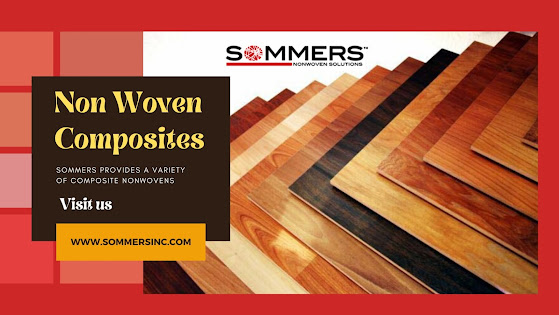Revolutionizing Industries: Exploring The Benefits Of Non-Woven Composites Materials
In today's rapidly evolving industrial landscape, the demand for advanced materials that offer superior performance and versatility is on the rise. Non-woven composites have emerged as a highly adapted material in this regard, revolutionizing numerous industries with their unique benefits and innovative applications. Combining the best characteristics of different materials, non-woven composites are transforming traditional manufacturing processes and unlocking new possibilities. But what are these non-woven composites, and how it is evolving and shaping many industries? Let's delve deeper into it from below.
What's involved in non-woven composites?
Composites are substances made mostly of two different components. Usually, one of the two components is referred to as the reinforcing phase and the other as the matrix. Particles, fibers, platelets, or flakes can make up the reinforcing phase. The continuous matrix is often made of ceramic, metal, or polymer components. At the macroscopic and microscopic levels, the two components of a composite are homogenous and heterogenous, respectively. Hence, the key advantage of using non-woven composites is the possibility of combining the properties of different individuals into a single material. '
The non-woven composites can be customized to meet the needs of certain applications and deliver optimal performance. But the process can't use monolithic materials like steel, aluminum, or plastics as their qualities can't be achieved. Simple characteristics like component volume percent, particle, or fiber size, shape, and distribution in the matrix can be changed to provide specific qualities.
They are mostly engineered materials created by combining fibers and resins in a non-woven structure. Unlike traditional textiles that are woven or knitted, non-woven composites are made by entangling fibers through mechanical, thermal, or chemical means to create a bonded fabric. This manufacturing process will allow for a high degree of flexibility in designing the composite's properties like strength, porosity, and permeability.
The superior characteristics of non-woven composites over traditional textiles
• Lightweight with high tenacity
Incorporating high-strength fibers like carbon, glass, polymers, etc., the non-woven composites achieve remarkable mechanical properties while remaining lightweight. This exceptional strength-to-weight ratio is highly valuable in the aerospace, automotive, and sports equipment industries. Here the weight reduction in materials brings more efficiency and improved performance.
• Tailored Properties
The versatility of non-woven composites would allow manufacturers to customize the material's properties to meet specific requirements. Industry consumers can select different fiber types, orientations, and resin systems; the technicians can modify the characteristics like flexibility, stiffness, impact resistance, etc. This tailoring capability enables the precise engineering of materials suitable for a wide range of applications in developing structural components.
• Enhanced Durability
Excellent durability and tolerance to different environmental variables are two qualities of non-woven composites. Since they are naturally resistant to corrosion, they are perfect for use in applications that are exposed to extreme conditions or chemicals. Additionally, the capacity of these materials to tolerate extremely high or low temperatures guarantees their stability and effectiveness throughout a broad operating range.
Contemporary applications of non-woven composites open up new opportunities
• Automotive Industry
Today the demand for lighter and more fuel-efficient vehicles is growing, which ultimately utilizes the non-woven composites that are transforming the automotive industry. They are mostly implemented in manufacturing components like body panels, interior trim, and underbody shields. The weight reduction achieved with non-woven composites contributes to improved fuel economy and reduced emissions without compromising safety or performance.
• Aerospace and Aviation
The aerospace sector benefits greatly from the use of non-woven composites. These materials find applications in aircraft structures, including wings and interior components. Non-woven composites enhance fuel efficiency, extend range, and improve overall aircraft performance by reducing weight and increasing strength.
• Medical and Healthcare
Non-woven composites find numerous applications in the medical field, including wound dressings, surgical drapes, and disposable garments. Their excellent moisture management properties, barrier performance, and flexibility make them ideal for medical usage.
• Filtration Systems
The use of non-woven composites has revolutionized the field of filtration to offer superior efficiency and extend the lifespan. Their high porosity and controllable pore size make them suitable for air and liquid filtration applications. Whether it is in air purifiers or water treatment systems, the use of non-woven composites can deliver enhanced filtration performance and improved sustainability.
• Renewable Energy
From wind turbine blades to solar panels, many structures are built using advanced non-woven composite materials. These composites provide the necessary strength, durability, and resistance to withstand the harsh conditions associated with solar or wind energy conversion.
Takeaways:
Non-woven composite materials have emerged as an inventive solution for revolutionizing industries through their unique benefits and innovative applications. With their lightweight yet high-strength characteristics, tailored properties, and enhanced durability, the non-woven composites offer a new paradigm for material engineering. From automotive to renewable energy and healthcare to aerospace industries, non-woven composites bring more innovation and advancement opportunities. As industries strive for improved performance, efficiency, and sustainability, non-woven composites are paving the way for transformative solutions.



Comments
Post a Comment